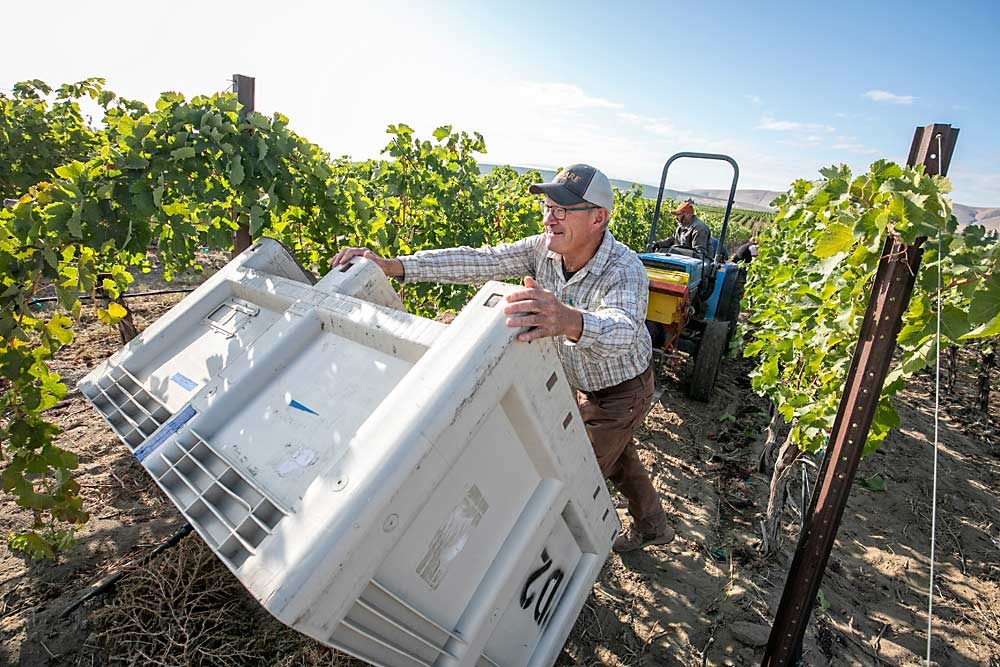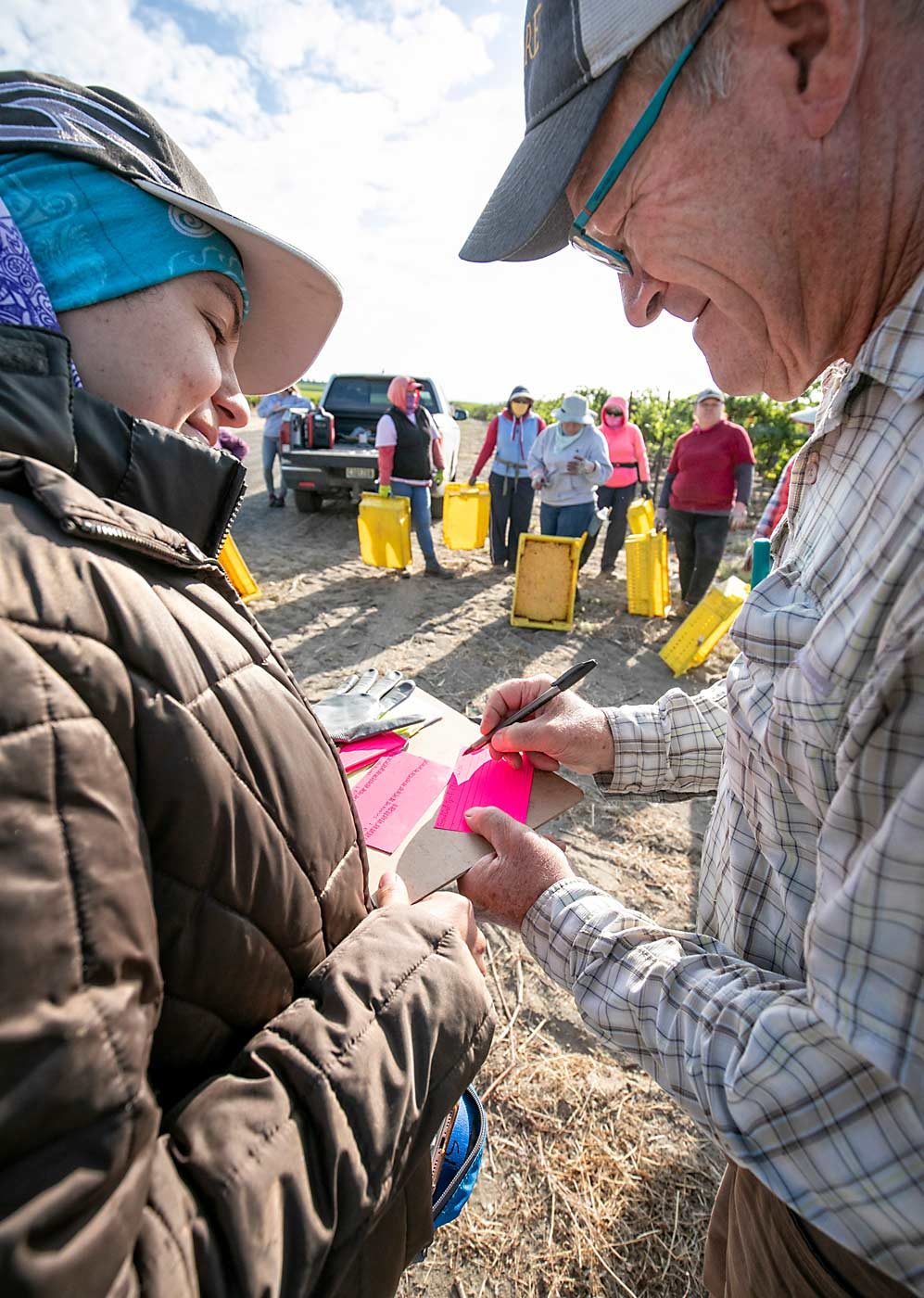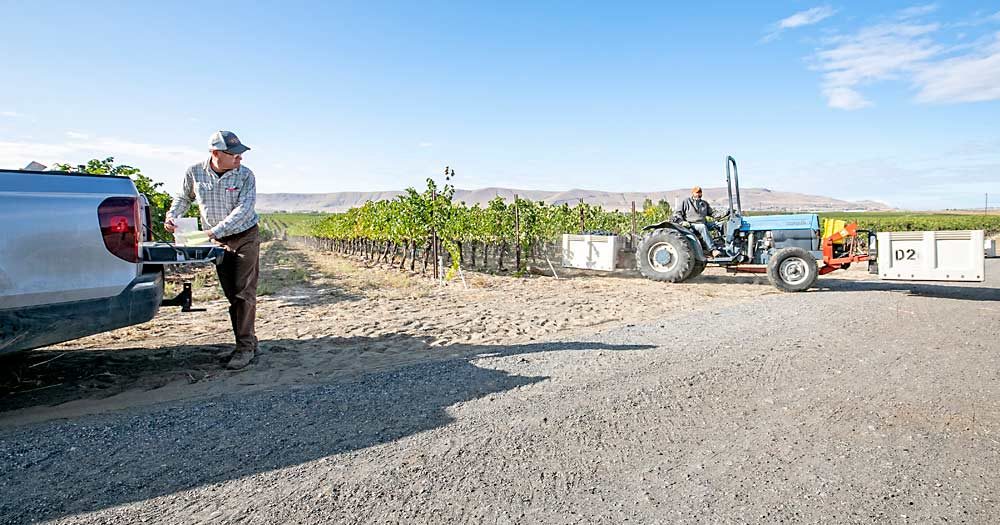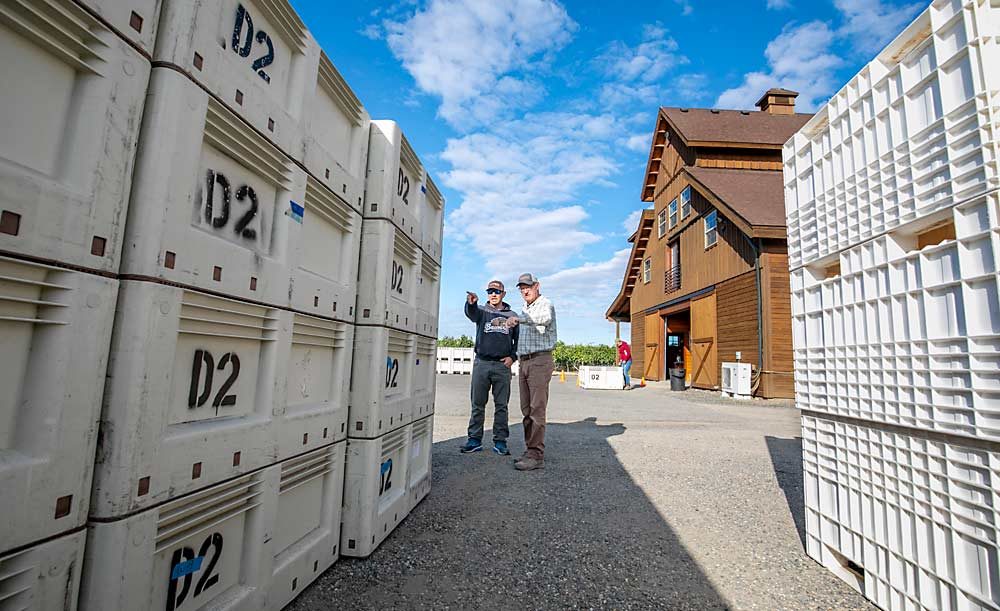
Dick Boushey’s favorite vineyard is a freshly picked vineyard.
“Now I can stop worrying about them,” he said, smiling at the empty vines in a Syrah block on Red Mountain where his crew had just finished harvesting in September. Bins of fruit waited for a refrigerated truck to haul them to a Woodinville, Washington, winery, as about a dozen workers waited for their next assignment.
But moments to relax are rare for the in-demand Yakima Valley grower who manages vineyards for 11 owners — 12 if you count his own 200 acres in Grandview, which he farms for over 50 winemakers. That’s a lot of bosses with different opinions about how their grapes should be managed and picked — and even more lots to harvest, bins to find, logistics to coordinate, and so forth.
It makes for a very hectic harvest, but Boushey says his business structure provides the economy of scale needed to make small, high-end vineyard management possible. Small, boutique wineries are big business in Washington, and a small but growing number of custom farmers such as Boushey help to make it possible.
“All these little wineries, at 20 to 40 acres, they can’t afford to have people full time or can’t afford the equipment,” he said. Instead, he employs 45 to 50 people, working year-round to prune, thin and harvest, moving them from vineyard to vineyard. “I let them treat this fruit like it’s their own,” he said.
The crew picks in pairs, one on each side of the vine. The women are paid piece-rate for harvesting and the men on the crew are paid hourly for hauling full totes back to the bin and loading the bins. It’s an efficient system that results in cleaner fruit, he said.
Many have worked for him for decades and he trusts them. Boushey occasionally interrupts with a quality control concern — clusters with signs of sunburn that made it into a bin, or an overflowing bin that can’t be stacked — but mostly he’s juggling calls from winemakers asking about developing fruit quality or changing pick-date plans.

“Some people are really good at planning; some are like, ‘Can you pick tomorrow?’” Boushey said, looking down at his calendar after a winemaker called to request that harvest get pushed back a week. Everyone’s eager to get the fruit off the vines, himself included, but with the cool, wet September weather, the fruit was taking its time, he said.
Colleagues say Boushey’s success comes from a rare combination of experience — hallmarked by a farmer’s common sense and a winemaker’s understanding of flavor development — and relationships throughout the Washington wine world, for which he serves on many boards and committees.
“All winemakers have their own unique style of remote farming, and (Boushey) has really learned to handle that,” said longtime grower Rick Hamman, who recently retired from Hogue Cellars but still serves on the Washington Wine Commission’s research arm with Boushey. “He’s quite involved in how the industry has evolved. He takes every research proposal seriously and tries to integrate new findings.”
Harvest
The day Good Fruit Grower visited in September, he was trying to track down missing bins, which the logistics company had delivered to a different vineyard.
That sort of commotion is commonplace on Red Mountain — a patchwork of small, high-end vineyards — during harvest, said grower Jim Holmes of Ciel du Cheval, where Boushey ultimately found his misplaced bins.
Boushey juggles more logistics than anybody else in the region, but it’s not just his services as a manager that have him in such high demand, Holmes said.
“A small vineyard can’t support the crew or the equipment alone, sure, but with Dick it’s more than that. He’s highly respected and his work is expected to produce top-end grapes,” Holmes said. “His name associated with your product helps sell it.”
Winemaker Chris Upchurch has worked with Boushey for 25 years and praises his hands-on approach and the trusting relationships he builds with winemakers.
“He’s one of those guys who hates to say no to anybody,” Upchurch said. That’s what makes him a great business partner, and what makes his harvest season so hectic. “He’s certainly not perfect, but I’ll take his mistakes over anybody else’s,” Upchurch said.
But he may have to start saying no more often, Boushey said, reflecting on his busy season. He’s not considering retirement, but “I can’t do all this running around forever,” he said.

This season ended up particularly frantic, after an injury in October prevented Boushey from doing any running around at all, confining him to his couch for weeks, while his wife, Luann — who usually sticks to the business end of the business — managed the crews to keep harvest going.
Then, an early freeze hit the region, complicating even the best-laid plans for wine grape harvest. Luckily, his son-in-law, Justin Lyons, who previously worked with him, came back to help out and be Boushey’s eyes in the vineyard.
“Neighbors and friends really helped me get this crop in,” Boushey said. Neighbors started his wind machines, winemakers were flexible, his crew stepped up, and the community rallied around him. “It was sort of humbling,” he said.
The vineyards
On Red Mountain, you can tell if it’s a vineyard Boushey has managed since its inception if the rows are angled 15 degrees off from running directly north-south. “It divides the sunlight more equally at our latitude,” he said. “If you go true north-south, you are getting baked in the afternoon.”
The core of his approach to viticulture is keeping the vines in balance. Sometimes, winemakers will want to bring a crop down too low, due to the perception that the lighter the crop, the richer the flavors, Boushey said, but that’s not always the case. It depends on what the site and the season can ripen.
Take, for example, the Syrah harvested for Long Shadows Vintners at 3.5 to 4 tons per acre.
“You can’t crop it down further or you will get high sugars but not the rest of the flavors,” he said. “Some people say, ‘Let’s just go down to a ton, that will give the best quality,’ but there’s a law of diminishing returns.”
Hanging a little more fruit extends the season to build those flavors, and the desired flavor profile depends on when you pick, he added. “Some people like to pick a little early, some like those big jammy flavors. It’s all about when you pick,” he said.
Big flavors are the hallmark of Red Mountain, where ample sunshine and high heat units mean growers can ripen anything, yet a diverse soil profile offers lots of variety, from rocky basalt to deep sand.
“From the beginning, they’ve been making really high-end wine here,” Boushey said. The grapes then merit intense management, such as an extra leaf stripping pass a few weeks before harvest in Cabernet Sauvignon clone 6 that gives an extra boost of light exposure on the shady side and makes it easier for workers to pick.

At his home farm in Grandview, which is about 20 miles west of Red Mountain, “I can’t grow Cab like they do here,” he said. “Mine is more light on its feet, bright, balanced and lower alcohol. Certain people like that.”
The grapes he manages on Red Mountain are, on average, worth twice as much as his Grandview grapes, even though they sometimes end up in the same bottles. It’s cooler on his farm, well suited to Rhone whites such as Marsanne, Roussanne and Piquepoul, along with Syrah, Merlot and Grenache, plus organic juice grapes at the lower elevations.
He’s proud of the Yakima Valley vineyards, where he first planted wine grapes in 1980, and how viticulture in the region has grown.
“We made all the mistakes in the Yakima Valley first. These areas (Red Mountain) started and learned from that. We moved up the hills and onto the southwest slopes,” he said. He likes the challenge of growing for high-end wines in the Yakima Valley.
But the reputation of those Yakima Valley grapes is now improving too, he said, and some high-end winemakers are tapping into their unique flavors. Though he’s too modest to say so, the renown of his vineyards plays a big role in that.
“It’s only 20, 25 miles apart and it’s like two different worlds,” he said. Each region’s niche meets the needs of different winemakers, too. “(Betz Family Winery) has a Syrah here and a Syrah from my place and they are so different, it gives them a style and a place to market,” he said. “That’s what I want to do is bring out the best of each area.” •
—by Kate Prengaman






Leave A Comment